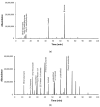Impact of Bottle Aging on the Composition and Sensory Properties of Flavored Chardonnay and Shiraz Wines
- PMID: 32882844
- PMCID: PMC7555831
- DOI: 10.3390/foods9091208
Impact of Bottle Aging on the Composition and Sensory Properties of Flavored Chardonnay and Shiraz Wines
Abstract
Natural flavorings could potentially be used to enhance the intensity of wine aroma and flavor; albeit since flavor additives are not legally permitted winemaking aids, flavored wines would need to be labeled as wine products. In this study, changes in the composition and sensory profiles of flavored Chardonnay (n = 2) and Shiraz (n = 2) wines were compared at bottling, and then again after 12 months of bottle aging. Flavorings and flavored wines were also analyzed by gas chromatography-mass spectrometry (GC-MS) to determine the key constituents responsible for changes to aroma and flavor profiles. However, many of the volatile compounds identified in flavor additives were not detected at appreciably higher concentrations in flavored wines, which was attributed to the very small quantities of flavorings that were added to base wines. The sensory profiles of control and flavored wines were determined by descriptive analysis, and the addition of flavorings to base wines significantly influenced the perception of some sensory attributes. Flavored Chardonnay wines exhibited enhanced fruit aromas and flavors, while fruit and developed attributes were enhanced in flavored Shiraz wines. Differences in sensory profiles were less apparent in Chardonnay wines following bottle aging, but depending on the flavorings added, flavored Shiraz wines could still be discriminated from their corresponding control wines after bottle aging. Results from this study demonstrate the potential for flavor additives to be used to enhance desirable attributes and/or mitigate wine sensory deficiencies.
Keywords: GC-MS; bottle aging; descriptive analysis; flavor additives; wine; wine product.
Conflict of interest statement
The authors declare no conflict of interest. The funders had no role in the design of the study; in the collection, analyses, or interpretation of data; in the writing of the manuscript, or in the decision to publish the results.
Figures
Similar articles
-
Variations in physicochemical characteristics, antioxidant activity, phenolic and volatile profiles, and sensory attributes of tea-flavored Chardonnay wine during bottle aging.Food Funct. 2023 Sep 19;14(18):8545-8557. doi: 10.1039/d3fo03137c. Food Funct. 2023. PMID: 37656435
-
A matter of place: Sensory and chemical characterisation of fine Australian Chardonnay and Shiraz wines of provenance.Food Res Int. 2020 Apr;130:108903. doi: 10.1016/j.foodres.2019.108903. Epub 2019 Dec 17. Food Res Int. 2020. PMID: 32156353
-
Evolution of the Aroma of Treixadura Wines during Bottle Aging.Foods. 2020 Oct 8;9(10):1419. doi: 10.3390/foods9101419. Foods. 2020. PMID: 33049919 Free PMC article.
-
The Impact of Different Closures on the Flavor Composition of Wines during Bottle Aging.Foods. 2021 Sep 2;10(9):2070. doi: 10.3390/foods10092070. Foods. 2021. PMID: 34574180 Free PMC article. Review.
-
Effects of sugar concentration processes in grapes and wine aging on aroma compounds of sweet wines—a review.Crit Rev Food Sci Nutr. 2015;55(8):1053-73. doi: 10.1080/10408398.2012.680524. Crit Rev Food Sci Nutr. 2015. PMID: 24915355 Review.
Cited by
-
Characterization of Key Aroma Compounds of Zhuyeqing by Aroma Extract Dilution Analysis, Quantitative Measurements, Aroma Recombination, and Omission Studies.Foods. 2025 Jan 21;14(3):344. doi: 10.3390/foods14030344. Foods. 2025. PMID: 39941938 Free PMC article.
References
-
- Fischer U. Wine aroma. In: Berger R.G., editor. Flavours and Fragrances. Springer; Berlin/Heidelberg, Germany: 2007. pp. 241–267.
-
- Rapp A., Mandery H. Wine aroma. Experientia. 1986;42:873–884. doi: 10.1007/BF01941764. - DOI
-
- Sinki G.S., Gordon R.J. Flavoring agents. In: Branen A.L., Davidson P.M., Salminen S., Thorngate J.H., editors. Food Additives. 2nd ed. Marcel Dekker; New York, NY, USA: 2001. pp. 349–408.
-
- Food Standards Australia New Zealand Food Standards Codes 2.7.4 and 4.5.1. [(accessed on 1 August 2020)]; Available online: http://www.foodstandards.gov.au/
-
- Mueller S.C., Umberger W.J. Are consumers indeed misled? Congruency in consumers’ attitudes towards wine labeling information versus revealed preferences from a choice experiment. Paper presented at the Annual Meeting of the Agricultural and Applied Economics Association; Proceedings of the Agricultural and Applied Economics Association; Denver, CO, USA. 25–27 July 2010; - DOI
Grants and funding
LinkOut - more resources
Full Text Sources
Miscellaneous


